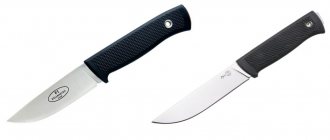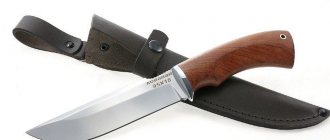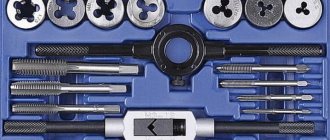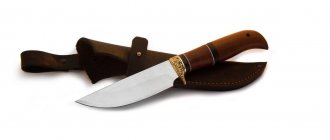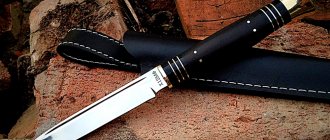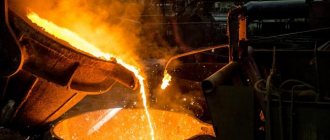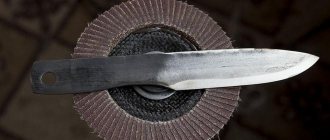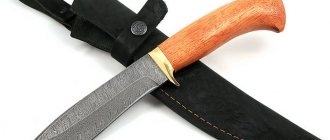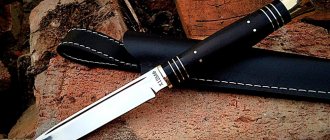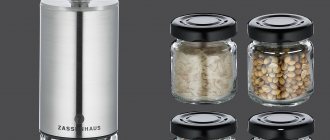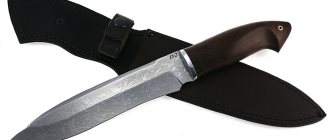Resistance to rust, dullness, and mechanical damage depends on the quality of heat treatment and alloy composition of knife blades. When choosing the best steel for a knife, the purpose of the product is taken into account: for use in the kitchen or in camping conditions, a different combination of characteristics plays a role.
The steel for the knife must be hard (55 units), durable and resistant to corrosion processes.
What criteria must steel meet?
Different types of steel have different technological and mechanical properties due to the presence of alloying elements in the alloy.
Material for making knives is assessed according to the following criteria:
- Resistant to a wide temperature range (-30…+100°C).
- Sensitivity to corrosion.
- Strength, elasticity. When using the product, minimal deformation of the metal and resistance to longitudinal deflection are important.
- Hardness. The indicator is denoted by the abbreviation HRC (in Europe - RC), assessed on the Rockwell scale. For knives, an indicator above 55 units is considered optimal. As hardness increases, chip resistance decreases.
- Holding an edge. The harder the material, the less often the blade becomes dull.
Another criterion is the ease of sharpening the blade. The softer the material, the easier it is to sharpen (the steel dulls faster). Therefore, a balance between hardness and strength is important.
There is no clear answer to the question of which steel is the best. Priority characteristics should ensure the functionality of the knife to perform the assigned tasks.
Composition and additives
Pieces of high carbon 1095 steel and 15n20 steel with a lot of nickel.
Steel is an alloy of iron and carbon. The rigidity of the material depends on the last element.
The following types of steel are distinguished:
- low carbon;
- medium carbon;
- high carbon.
Knives made of unalloyed steel (without additives) are flexible, but are susceptible to corrosion and are not resistant to damage. To improve the characteristics of the metal, impurities are added to the alloy. The table provides a list of additives used (brief explanations of their functions).
| Element | Functions |
| Manganese (Mn) | Provides strength, allows you to make any blade shape. Present in most steel alloys. |
| Molybdenum (Mo) | Allows you to harden steel to a high level of hardness, makes the blade heat-resistant, and reduces the fragility of the blade. |
| Chromium (Cr) | Protects against the effects of rust. |
| Vanadium (V) | Responsible for resistance to chemicals and increases elasticity. Increases the service life of the product. |
| Silicon (Si) | Reduces the material's susceptibility to mechanical stress, increasing strength. |
| Nickel (Ni) | Prevents steel from rotting and increases corrosion resistance. |
| Tungsten (W) | Increases strength and enhances anti-corrosion properties. |
Sulfur and phosphorus are considered technological impurities. The first element reduces the hardness and strength of the metal; in high-quality alloys the percentage does not exceed 0.065. Phosphorus increases the brittleness of steel. This element is present in all alloys, but the maximum level of the substance in the alloy is 0.045%.
Heat treatment
D2 steel is produced by the electroslag remelting (ESR) method, in which the molten metal is passed through a special flux. During the process, harmful impurities of sulfur and phosphorus are removed from the melt as much as possible, thereby improving the quality of the metal.
To obtain the required strength characteristics for knives, D2 steel is subjected to further heat treatment. During hardening, it is important to ensure uniform heating of the entire mass of metal, for which a short delay is sufficient. Heating is carried out in an oxidizing environment, which causes partial decarburization of the surface layer. It is removed during final processing.
The primary hardness of the metal is achieved by hardening at 1000-1010 degrees with exposure for 5-7 minutes. The tempering temperature range is 175-200 degrees. This mode ensures maximum cutting edge hardness – 61-62 HRC.
To make knives intended for certain dynamic loads, the steel hardening mode changes slightly:
- hardening - at a temperature of 1020-1040 degrees;
- vacation - 310-340 degrees for two hours.
The final mechanical processing of products consists of grinding and sharpening the cutter.
Thermo-mechanical treatment conditions
This type of steel requires hardening, which gives it greater strength. To harden an alloy not intended for making blades, an oxidizing atmosphere is used. Creating blades from D2 steel requires a different technology.
Heat treatment of D2 steel
For the production of cutting blades and parts designed for dynamic loads, different exposure times and temperatures are required. The most common treatment of steel for primary hardness, including low tempering and quenching in oil, under a stream of air or in hot environments.
To achieve uniformity in the structure of the blade, ensure uniform heating during hardening. The absence of oxidation during such processing prevents decarburization, which helps maintain strength and make the product more sharp.
Heating occurs at a temperature of +690…+850°C. After a few minutes or seconds, the alloy is cooled and alloyed with vanadium and molybdenum, which promotes hardening.
The production uses the electroslag remelting method. The molten metal is passed through a layer of slag, in the process being cleansed of harmful impurities, including sulfur and phosphorus.
After processing followed by heating, the steel is cooled and subjected to final mechanical processing in the form of grinding and sharpening the blade.
The best foreign steel grades
Different brands of steel have different performance characteristics, all types have pros and cons.
D2
This is a German brand of high quality tool steel, characterized by uniform structure after hardening. One of the most sought after in the world.
Products made from German D2 steel for knives are distinguished by their homogeneous structure.
Advantages:
- sharpening retention;
- cut quality;
- resistance to corrosion and deformation.
D2 steel is a high-carbon type. Designed to create cutting teeth, used in the manufacture of hunting knives.
Contains a large amount of chromium (up to 14%). Hardened (55-69 HRC). At a low cost, it is hard, but difficult to sharpen.
To extend the service life, it is recommended to wipe the blade after contact with water.
CPM S35VN
The brand of the American company belongs to the premium class, characterized by hardness and wear resistance. The abbreviation CPM is the name of the Crucible Particle Metallurgy technology.
The alloy is produced by the powder method, which involves the following steps:
- The liquid melt is cooled with nitrogen, it crystallizes and turns into powder.
- The dry matter is subjected to high temperatures and pressure to sinter the powder.
- The alloy is pressed to produce the finished product.
Strength is ensured by chromium, niobium and vanadium carbides evenly distributed in the powder.
Knives made from American steel CPM S35VN retain their edge well, but are not resistant to bending.
The S35VN grade is an improved version of S30V (niobium is added to the alloy, and fine structure powder is used in production).
The combination of alloyed elements made it possible to improve the characteristics of steel without loss of strength, i.e.:
- Thanks to the fine-grained structure of the material, the product retains its sharpness for a long time and is less susceptible to chipping compared to the previous brand.
- The blade can withstand impact loads.
- Steel is less susceptible to rotting.
- The alloy is characterized by ductility.
The disadvantages of the brand include difficulty in sharpening and high cost. Such blades are not intended for cutting hard surfaces and are not resistant to bending (the hardness of the blade ranges from 58 to 62 on the Rockwell scale).
440C
It is considered a classic knife steel in Europe and America; it contains increased amounts of chromium and carbon.
Knives made of 440C steel are very rust-resistant.
Main characteristics:
- hardness is 59 HRC;
- withstands bending and twisting (can be used when cutting hard, dense products);
- belongs to the stainless steel type (suitable for scuba divers and fishermen);
- holds an edge;
- easy to edit.
Classic and folding knife models are made from 440C steel. Products require regular maintenance . Due to the absence of vanadium in the alloy, the blades are not wear-resistant. Compared to premium products, they are sensitive to salts and acids.
Elmax
Swedish steel is produced using powder technology. It is high-carbon, high-alloy. Used for making knives of a high price category. It has good cutting ability.
Products made from Swedish high-carbon steel Elmax are very durable and resistant to corrosion.
Benefits include:
- hardenability (58-62 on the Rockwell scale);
- plastic;
- impact resistance;
- wear resistance;
- corrosion resistance.
With high hardness, steel lends itself well to sharpening. To maintain anti-corrosion properties, regular grinding and polishing of the blade is necessary.
M390
The M390 brand developed by the Austrian metallurgical concern is one of the best. Characterized by resistance to rotting. It was conceived as a material for medical instruments, so special attention during development was paid to the ability to hold an edge.
The blades retain their edge sharpness for up to 6 months. The alloy has a low difference between ultimate yield and tensile strength. The material does not collapse when interacting with most types of alkalis and acids.
The main advantage is the hardness of 60 to 62 HRC. With this indicator, it is possible to polish the canvas to a mirror finish. Sharpening requires a tabletop machine.
ZDP 189
The ZDP 189 brand belongs to a Japanese corporation. This ultra-high carbon tool steel, with a hardness of up to 69 HRC, contains a high percentage of chromium. Developed based on powder technology.
It is distinguished by its cutting qualities and is used for the manufacture of limited series of blades. Due to its fragility, it is not suitable for all blade shapes (for example, not recommended for concave bevels). The canvas is sensitive to impact. The blade can be polished well.
VG-10
Co and Mo make VG-10 viscous and hard.
Alloyed with cobalt and molybdenum, the Japanese grade VG-10 is distinguished by its sharp cutting edge, hardness, resistance to impact loads, and anti-corrosion properties.
It is often used as the central layer of the blade to provide the blade with resistance to rust and improve cutting properties.
The cobalt content of the alloy makes the steel tough and hard. The cutting edge is maintained even at a hardness of 60-62 HRC. The quality of the material is maintained by a special heat treatment method, which the manufacturer keeps secret.
CPM S30V
American powder grade CPM S30V contains from 13 to 18% chromium, is durable and rust-resistant. The alloy contains vanadium and chromium carbides; there are areas of ultra-high hardness on the cutting edge.
The material combines impact strength and wear resistance, and is fracture resistant. The blades have a hardness of up to 58-61 HRC, and are easy to edit.
AUS-8
AUS 8 steel is often used to make kitchen knives of various sizes.
Japanese-made AUS-8 steel has high performance characteristics. The presence of molybdenum and nickel in the alloy provides corrosion resistance.
The smelting and hardening process does not use expensive technologies, so the metal has a low cost.
Blades made from this material do not require special care, combine hardness and elasticity, and are easy to sharpen.
The best domestic types of steel
The marking of two numbers and the letter “X” indicates the percentage content (in hundredths) of carbon and chromium (the first number is carbon, the second is chromium). Actual figures may vary slightly. We can highlight the top 5 best knife steels from domestic manufacturers.
50x14MF
Universal steel 50x14MF, with which weapons production began. Used in the manufacture of knives and medical instruments. The alloy is resistant to chemical and humid environments. Hardness can be up to 57-58 HRC.
The blades hold their sharpness for a long time, are resistant to shock loads, and can be easily straightened at home.
Steel 50x14MF is universal and suitable for forging knives and axes, as well as for the manufacture of medical equipment.
40Х12
This is a soft, high-alloy steel used in the production of inexpensive knives and souvenir blades. It does not lend itself well to hardening, so the blades bend easily, and the cutting edge almost does not hold an edge.
The advantage is resistance to corrosion. The hardness of the material is 51 or 52 HRC.
X12MF
Initially developed for use in the mechanical engineering industry. The brand is widely used in the manufacture of knives. The alloy contains recycled materials, which reduces production costs.
X12MF steel does not require complex maintenance, belongs to the group of corrosion-resistant materials, and is flexible during processing. The cutting edge is wear resistant. The sharpness of the blade is maintained for a long time. The hardness can reach 64 HRC.
Disadvantages include: sensitivity to bending and acidic environments, the need for special equipment for sharpening, dull appearance of the blade.
95Х18
Often used to make blades. The material is resistant to corrosion, durable, and does not wear out for a long time. The advantage is the ease of sharpening the blade, the disadvantage is the average aggressiveness of the cut. Hardened to 58 HRC.
Read more in the article: “Characteristics of steel for knives 95x18“
65Х13
Refers to inexpensive brands. It is resistant to rust due to its chromium content. Hardness ranges from 56 to 59 units. according to the Rockwell scale. The fabric is resistant to impacts and deformation. Another advantage is ease of operation and sharpening.
Disadvantages include high abrasion rates.
More details in the article: “Characteristics of steel grade 65X13“.
From the history of the creation of the alloy
D2 steel is a relatively new alloy. It was developed a little more than half a century ago in the USA using the electroslag remelting method, which improved the quality of the resulting alloy. With its help, phosphorus and sulfur are removed from the composition, which, according to the developers, are the most harmful. Their increased content often leads to defects and a decrease in the quality of steel.
In America, the alloy was used to make industrial cutting tools and knives.
Later, in Japan, Sweden and Germany, alloys of similar composition were developed, which in their properties are not inferior to the original sample, and in some respects even surpass it. The characteristics of D2 steel and similar ones developed in other countries differ slightly, mainly in the percentage of carbon content.
The Russian analogue of D2 is X12MF steel. The composition of the alloys is similar; differences in properties depend only on the proportions of components used in the alloys and the characteristics of heat treatment.
Currently, the alloy is used for the production of knives and edged weapon blades.
Which steel is better to choose
When choosing a kitchen knife or hunting blade, the quality of the material and the reputation of the manufacturer are taken into account.
For kitchen knives
To be used in the kitchen, a knife must be durable. An important parameter is the quality of the cut. The blades should be easy to sharpen, but not require frequent editing.
The best kitchen knives meet the following parameters:
- rust resistant;
- do not crumble;
- have a homogeneous fabric without streaks or bubbles.
Another parameter is the absence of irregularities on the cutting edge.
Kitchen knife made of steel 65Х13 with chromium content.
In Russia, the following brands are most often used for kitchen knives:
- 65Х13;
- 40X12;
- 95X18;
- 50Х14МФ.
Among foreign brands, 440C steel has a high rating. For kitchen knives, Japanese steels AUS10 and ATS34, as well as American grade 154 CM (USA), are recommended. Steel 420 is often used by foreign manufacturers, but preference should be given to manufacturers from the USA, Switzerland, Austria, and Germany.
Spanish knives made of 420 steel are soft. In European versions, a massive blade is often found, which makes it difficult to accurately cut food.
For hunting knives
Tourist and hunting blades must be made of durable material.
Examples of knives made of steel 95X18.
Brands often used:
- 420 (inexpensive models);
- 440A, B, C;
- AUS 4-10;
- Elmax;
- 95X18;
- H1 (American chromium-nickel steel).
The blade must have different cutting characteristics, remain sharp for a long time, be durable, and not crumble. Alloys with a hardness below 55 and above 60 units are not suitable for a hunting knife. according to the Rockwell scale. In the first case, the canvas will quickly lose its sharpness, in the second, it will be difficult to straighten. Material with a higher hardness rating may break.
Price
Knives made of D2 steel are produced by both domestic and foreign manufacturers. The products are low in cost. This is due to the fact that all the components that are used to produce this grade of steel are available and cheap. The average price for a knife is 2,500 rubles. Due to their low price and excellent characteristics, knives made from D2 steel are popular among buyers, especially among hunters and tourists.
Sources
- https://VashNozh.ru/stal/d2
- https://svarkaipayka.ru/material/stal/tehnicheskie-harakteristiki-legirovannoy-stali-d2.html
- https://damask-steel.ru/page/d2-plyusy-i-minusy-harakteristiki-otzyvy/
- https://www.nozhikov.ru/blogs/stati/stal-d2-kak-material-dlya-izgotovleniya-klinkovogo-oruzhiya
- https://kavkazsuvenir.ru/blog/stal-d2-dlya-nozhey
- https://posuda-gid.ru/nozhi/stal/35-d2-plyusy-i-minusy
- https://knifehacker.ru/stal-d2/
- https://top-nozhej.ru/bez-rubriki/stal-d2-dlja-nozhej-harakteristiki-pljusy-i-minusy/
Properties of powder steel
The powder steel manufacturing process comes down to the basic steps: production and mixing of powders, compaction and sintering. Manufacturers may have different process specifications.
Knives made of this steel are more expensive. The quality of the finished product depends on the size and distribution of the carbides formed. Using the technique allows manufacturers to obtain a high-tech alloy, increase the number of alloyed elements, and improve the characteristics of the material.
Most military and hunting knives are made using powder technology, because... in these cases, increased strength is required in combination with anti-corrosion properties.
Powdered steel blades are sharper than solid metal prototypes. Withstands temperature changes, is resistant to deformation, and can be sanded. The cutting edge retains its sharpness for a long time.
At home, powder steel requires careful sharpening.
